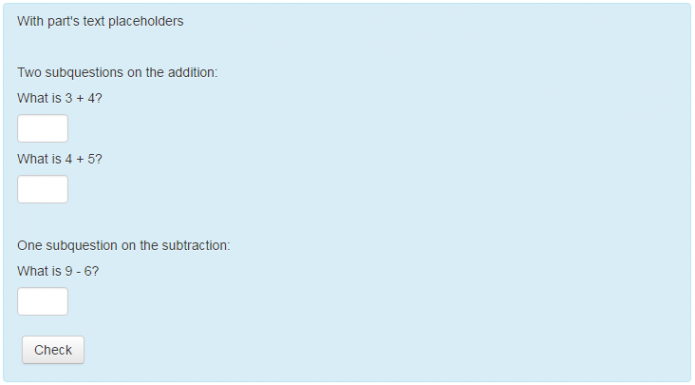Formulas: Parts' placeholders: Difference between revisions
No edit summary |
No edit summary |
||
| Line 26: | Line 26: | ||
<pre style="font-size:113%;width: 98%;"> | <pre style="font-size:113%;width: 98%;"> | ||
General | General | ||
Question name* A | Question name* A Formulas question with three part's placeholders | ||
Main question | Main question | ||
Question text* With part's | Question text* With part's placeholders | ||
Two subquestions on addition: | Two subquestions on addition: | ||
{#1a} | {#1a} | ||
Revision as of 22:37, 15 January 2018
Placeholders are useful for inserting the text of parts and answer boxes at specific points in the question. There are two types of placeholders:
- part's placeholder (discussed below)
- answer box placeholder (discussed on the next page)
The part's placeholder allows inserting the text of a part at a particular point in the main question. The placeholder name is a string starting with # and followed by a string of alphanumeric characters [A-Z a-z 0-9], such as #1, #a, #a1, #1a, #SubQuestion01, etc. Note that although the designation of the part's text placeholders is quite flexible, a simple designation such as #1, #2, #3, etc. is often sufficient.
At the point of insertion into the main question text, the placeholder name must be enclosed by curly braces { }. In the parts, the placeholder name is specified in the field called Placeholder name.
Use part's placeholders in the main question to insert the text of three parts.
General
Question name* A Formulas question with three part's placeholders
Main question
Question text* With part's placeholders
Two subquestions on addition:
{#1a}
{#1b}
One subquestion on subtraction:
{#2}
Part 1
Part's mark* 1
Answer type Number
Answer* 7
Grading criteria* Absolute error == 0
Placeholder name #1a
Part's text What is 3 + 4?
Part 2
Part's mark* 1
Answer type Number
Answer* 9
Grading criteria* Absolute error == 0
Placeholder name #1b
Part's text What is 4 + 5?
Part 3
Part's mark* 1
Answer type Number
Answer* 3
Grading criteria* Absolute error == 0
Placeholder name #2
Part's text What is 9 − 6?
The formulas question should look like this:
Play it Login info (Open in new tab: Ctrl+Shift+Click)
The same question can be obtained as follows. However, it is usually easier to use placeholders as above.
General
Question name* A formulas question with three parts and no part's text placeholders
Main question
Question text* Without part's text placeholders
Note: In general, it is more convenient to use placeholders as is done above.
Part 1
Part's mark* 1
Answer type Number
Answer* 7
Grading criteria* Absolute error == 0
Placeholder name
Part's text Two subquestions on the addition:
What is 3 + 4?
Part 2
Part's mark* 1
Answer type Number
Answer* 9
Grading criteria* Absolute error == 0
Placeholder name
Part's text What is 4 + 5?
Part 3
Part's mark* 1
Answer type Number
Answer* 3
Grading criteria* Absolute error == 0
Placeholder name
Part's text One subquestion on the subtraction:
What is 9 − 6?
